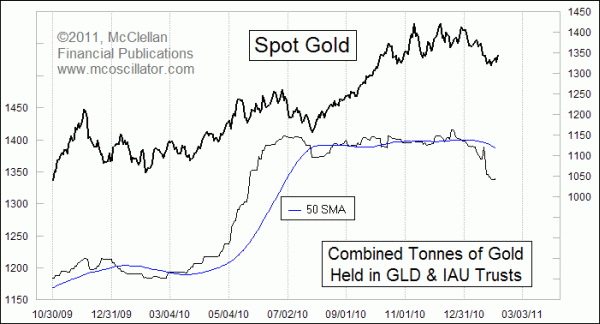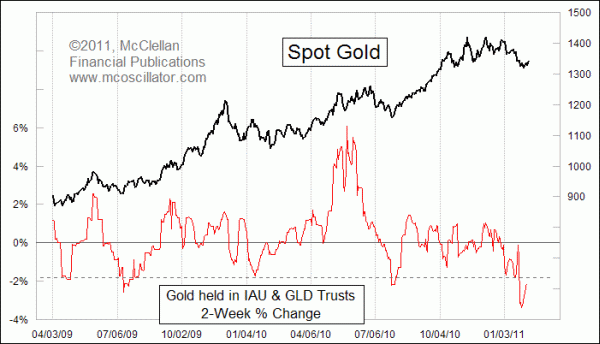Gold ETF Assets

Free Chart In Focus email
Delivered to you every week
Since its debut in late 2004, the GLD Trust has seen a steady growth in its assets as investors turn to this ETF as a way to "own" gold bullion. The trust issues shares and uses the proceeds to purchase gold bullion that is kept in storage. As demand rises, the trust can issue more and more shares as a means of keeping the trading price of the shares close to the net asset value of each share.
It works the same in the other direction too. If more investors want to sell their shares of GLD and create a pricing inefficiency, GLD can step in and redeem shares, selling its bullion on the spot market to get the money to cover those redemptions.
Another gold bullion ETF, the IAU Trust, was started by iShares just a couple of months after GLD, and it has been struggling ever since to catch up to GLD's dominant position. IAU got a boost in its asset growth at the expense of GLD during 2010 when IAU cut its management fees.
This week's chart looks at the total tonnes (1000 kg) held by both GLD and IAU. As we can see, assets tend to rise during uptrends in gold prices, as more traders decide that they want to participate. The imbalance of demand for shares of these ETFs leads their sponsoring firms to issue more shares, and buy up more bullion. During downtrends in gold prices, people decide to flee those positions, creating an imbalance in the other direction and resulting in a drop in total gold held.
You can access the raw assets data here: GLD Assets and IAU Assets
The point at which it gets interesting is when we see a sharp drop in total assets, reflecting a more urgent desire by investors to get out of their gold positions. The chart below shows one way to capture those events, using a 2-week rate of change. That's simply a reflection of where the total assets are now versus where they were 2 weeks before.

When total assets drop by 2% or more over a two week period, it marks a pretty reliable indication of a bottom for gold prices. It does not quite work as well for big positive changes in assets, perhaps because of a big underlying uptrend in asset growth as these ETFs gain greater investor acceptance. And the psychology of gold traders does not work the same for up moves as it does for down moves.
In our twice monthly McClellan Market Report and our Daily Edition, we have been discussing with readers our expectation for an important 13-1/2 month cycle bottom in gold prices due to arrive in February 2011. That cycle is only accurate to plus or minus a month, so as the cycle bottom date gets closer one must turn to other tools to focus in on where the bottom is. This 2-week rate of change in ETF assets represents one way to help us find out that a bottom-worthy shift in investor sentiment has occurred.
Tom McClellan
Editor, The McClellan Market Report
Nov 19, 2010
Is Gold Overvalued? |
Oct 14, 2010
Gold Prices Lead The Way For Commodities |
Apr 09, 2010
Rydex Assets Levels Show Investor Sentiment |